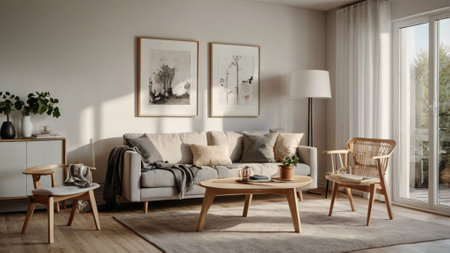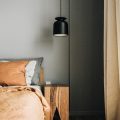Understanding the Importance of Layered Lighting
When designing a living room that truly embodies British comfort and sophistication, it’s essential to embrace the art of layered lighting. Rather than relying on a single source of illumination, experts recommend blending three key lighting types—ambient, task, and accent—to achieve both practicality and atmosphere in your space. This approach not only accommodates the varied activities that take place in a typical British living room—from afternoon tea to cosy evenings with a book—but also enhances architectural features and creates a welcoming environment for guests.
The Three Layers of Lighting
| Lighting Type | Purpose | British Living Room Example |
|---|---|---|
| Ambient | General illumination, sets the overall mood | Pendant ceiling lights, wall-mounted sconces |
| Task | Focused light for specific activities | Reading lamps beside armchairs, table lamps for hobby corners |
| Accent | Highlights features or adds decorative interest | Picture lights above artwork, LED strips along shelving alcoves |
Why Layered Lighting Matters in British Homes
The unique character of British interiors often comes from their blend of tradition and contemporary style. Many homes feature period details like coving, fireplaces, or bay windows—elements that deserve to be showcased. By thoughtfully combining ambient, task, and accent lighting, you can ensure every corner is functional and every detail shines. Moreover, British weather calls for adaptable schemes: layered lighting lets you create a bright setting on grey days or dial up warmth and intimacy during long winter evenings.
2. Embracing Natural Light in British Homes
One of the most cherished elements in British interior design is the celebration of natural light. The unique character of UK homes, often featuring beautiful bay windows and traditional sash windows, offers ample opportunities to maximise daylight. Understanding how to harness and enhance this natural resource is fundamental when curating the perfect lighting scheme for your living room.
Optimising Daylight with Classic Features
Bay windows and sash windows are iconic in British architecture, not only adding period charm but also inviting generous streams of daylight into living spaces. To optimise these features:
| Feature | Design Tips |
|---|---|
| Bay Windows | Keep window dressings minimal with light voile curtains or Roman blinds. Position seating nearby to create a bright reading nook or a sunlit gathering spot. |
| Sash Windows | Restore original timber frames and use sheer fabrics to diffuse light without blocking it. Consider painting window recesses in lighter shades to amplify brightness. |
Blending Natural and Artificial Light
The British climate means that daylight can be fleeting, especially during overcast months. To maintain a welcoming atmosphere, its essential to thoughtfully blend natural and artificial light sources. Layering is key: combine ceiling lights, wall sconces, and floor lamps to complement changing daylight levels throughout the day.
Top Tips for British Living Rooms:
- Orient mirrors opposite windows to bounce sunlight around the room.
- Select LED bulbs with a warm colour temperature for cosy evenings.
- Choose adjustable fixtures like dimmable overhead lights or multi-arm floor lamps for flexibility as daylight shifts.
By respecting architectural features and balancing both natural and artificial lighting, you’ll create a living room that feels bright, inviting, and distinctly British—whatever the weather may bring.

3. Selecting Statement Fixtures with a British Aesthetic
When it comes to curating the perfect lighting scheme for your living room, statement fixtures play an essential role in both illumination and style. In Britain, lighting often serves as a focal point that bridges tradition with contemporary flair. Whether your home is a charming Victorian terrace or a sleek city flat, choosing the right pendants, chandeliers, and wall sconces can elevate your space while honouring quintessential British design sensibilities.
Pendants: Timeless Elegance Meets Modern Utility
Pendant lights are beloved in British interiors for their versatility and ability to define zones within open-plan living spaces. For period properties, opt for glass or brass pendants inspired by Georgian or Edwardian eras. In more modern settings, industrial-inspired metal shades or minimalist globe designs offer a subtle nod to classic British understatement.
Popular Pendant Styles in British Living Rooms
| Pendant Style | Best For | Iconic Features |
|---|---|---|
| Glass Dome Pendants | Victorian/Early 20th-century Homes | Etched glass, antique brass fittings |
| Industrial Metal Pendants | Contemporary Flats | Matte black or brushed copper finish |
| Ceramic Pendants | Cottage Interiors | Hand-painted motifs, soft pastel colours |
Chandeliers: Grand Statements for Every Ceiling Height
The chandelier is an enduring symbol of British grandeur—from ornate crystal fixtures in stately homes to simple wrought-iron pieces in rural cottages. If your ceiling height allows, a traditional multi-arm chandelier adds instant drama. For smaller rooms or lower ceilings commonly found in urban flats, consider compact designs with clean lines or vintage-inspired flush mounts for a touch of old-world charm without overwhelming the space.
Choosing Chandeliers by Property Type
| Property Type | Recommended Chandelier Style |
|---|---|
| Period Townhouse | Crystal or brass with candle-style bulbs |
| Cottage/Converted Barn | Iron or wood, rustic finishes |
| Modern Flat | Sleek chrome or contemporary glass clusters |
Wall Sconces: Subtle Sophistication and Heritage Detailing
Wall sconces are a staple in British interiors, providing layered lighting while enhancing architectural features like fireplaces or alcoves. Seek out fixtures with details such as pleated fabric shades, aged bronze patinas, or traditional swing arms. For newer builds, slimline sconces with frosted glass add soft ambient light without cluttering the walls.
Expert Tip:
Select finishes and shapes that echo existing hardware—think door handles and curtain rods—for a cohesive look typical of well-considered British decor. By blending heritage-inspired pieces with contemporary accents, you can achieve a lighting scheme that feels both timeless and distinctly personal.
4. Tailoring Lighting to Heritage Architecture
Britain’s rich architectural heritage, from elegant Georgian townhouses to ornate Victorian terraces and sleek mid-century homes, calls for a lighting approach that respects the building’s character while meeting modern lifestyle needs. When planning your living room lighting scheme, it’s essential to consider both the era-specific features and the unique spatial qualities of your property.
Insights into Respecting Architectural Character
Each architectural period offers distinct details—think decorative cornices in Victorian homes, high ceilings and grand sash windows in Georgian properties, or minimalist lines in mid-century spaces. Successful lighting design enhances these elements rather than competes with them. Consider layering light sources: a combination of ambient, task, and accent lighting allows flexibility while highlighting heritage features such as fireplaces, mouldings, or original floorboards.
Matching Lighting Styles to Period Features
| Architectural Style | Key Features | Recommended Lighting Approach |
|---|---|---|
| Victorian | Ornate plasterwork, deep coving, stained glass | Opt for traditional chandeliers or wall sconces with warm hues; use picture lights to accentuate artwork or mantelpieces. |
| Georgian | Tall windows, symmetrical layouts, ceiling roses | Choose elegant pendant fixtures or candelabra-style fittings; uplighters can emphasise generous ceiling heights. |
| Mid-Century | Clean lines, open plans, large panes of glass | Select minimalistic pendants and discreet recessed spotlights; integrate statement lamps as sculptural accents. |
Honouring History with Modern Functionality
While it’s tempting to embrace ultra-modern lighting technology, thoughtful integration is key. For listed or conservation properties, opt for wireless LED solutions that minimise intervention with historic fabric. Dimmable controls enable you to adjust atmosphere without compromising authenticity. Ultimately, a sensitive approach ensures your living room glows with contemporary comfort while celebrating its British architectural heritage.
5. Creating Atmosphere: The Role of Dimmers and Lamps
One of the defining features of British living rooms is their inviting warmth, often achieved through careful attention to lighting layers and controls. Dimmer switches play a pivotal role in this, allowing you to tailor the intensity of your overhead lights to suit everything from afternoon tea to cosy film nights. With a simple adjustment, you can shift the mood from bright and lively for social gatherings to soft and relaxing for quiet evenings at home.
The Strategic Use of Table and Floor Lamps
Table and floor lamps are more than just functional—they are integral to the British approach to creating a comfortable, lived-in feel. Placing lamps in corners, beside reading chairs, or on console tables helps break up harsh shadows and introduces pools of gentle illumination. This layering effect fosters intimacy and invites relaxation, echoing the timeless charm found in classic British interiors.
Comparing Lighting Types for Living Room Atmosphere
| Lighting Type | Atmospheric Effect | Best Placement |
|---|---|---|
| Dimmer Switches | Adjusts room brightness; versatile mood setting | Main ceiling lights or wall sconces |
| Table Lamps | Adds focused, warm light; enhances cosiness | Side tables, mantels, window sills |
| Floor Lamps | Casts ambient light; fills dark corners elegantly | Behind sofas, next to armchairs |
Tip from British Interior Experts:
Avoid relying solely on overhead fixtures—layering your lighting with dimmers and lamps creates depth and comfort, reflecting the hallmark hospitality of British homes. Experiment with lamp shades made from fabric or parchment for diffused glow, and choose classic designs that complement your living room’s overall aesthetic.
Eco-Friendly Choices: LED and Low-Energy Options
In today’s British homes, sustainability sits at the heart of good interior design. Choosing eco-friendly lighting is no longer just a trend; it’s a responsibility, especially when curating a living room that reflects both style and conscience. The UK’s commitment to reducing carbon emissions means opting for energy-saving bulbs and fixtures is not only practical but aligns perfectly with local values.
Understanding Energy-Saving Bulbs
When selecting bulbs, LED (Light Emitting Diode) options remain the gold standard in British interiors. They offer longevity, lower running costs, and come in a variety of colour temperatures to suit every mood and scheme—from warm and inviting to crisp and modern. Compact Fluorescent Lamps (CFLs) are another alternative, but LEDs have the edge due to instant brightness and mercury-free composition.
Comparison of Common Bulb Types
| Bulb Type | Average Lifespan | Energy Efficiency | Best For |
|---|---|---|---|
| LED | 15,000–25,000 hours | Up to 90% less than incandescent | Main lighting, accent features, dimmable fixtures |
| CFL | 8,000–10,000 hours | Approx. 70% less than incandescent | Lamps, wall sconces |
| Halogen (phasing out in UK) | 2,000 hours | Less efficient, higher heat output | Task lighting (being replaced by LED) |
Selecting Sustainable Fixtures Without Compromising Style
The shift towards greener choices doesn’t mean sacrificing aesthetics. British brands increasingly offer beautifully crafted fittings made from recycled metals or sustainably sourced timber—perfect for anything from Edwardian bay windows to sleek, contemporary flats. Look for fixtures with replaceable LED modules or those labelled as “energy rated,” ensuring your stylish selection stands the test of time and efficiency.
Top Tips for a Stylish & Sustainable Living Room Lighting Scheme:
- Layer your lighting: Combine ceiling pendants with table lamps fitted with low-energy bulbs for both flexibility and ambiance.
- Dimmable LEDs: Opt for dimmable LED bulbs to easily adjust light levels, saving energy while setting the mood for cosy evenings or lively gatherings.
- Tasteful solar accents: Consider solar-powered accent lights near windows or conservatories—a nod to British garden culture even indoors.
- Smart controls: Install smart switches or timers so lights aren’t left on unnecessarily—effortless efficiency with a modern touch.
Sustainable choices should feel effortless and elegant. By integrating LED and low-energy options into your living room design, you embrace the best of British interiors: timeless beauty, thoughtful function, and an enduring respect for the environment.


